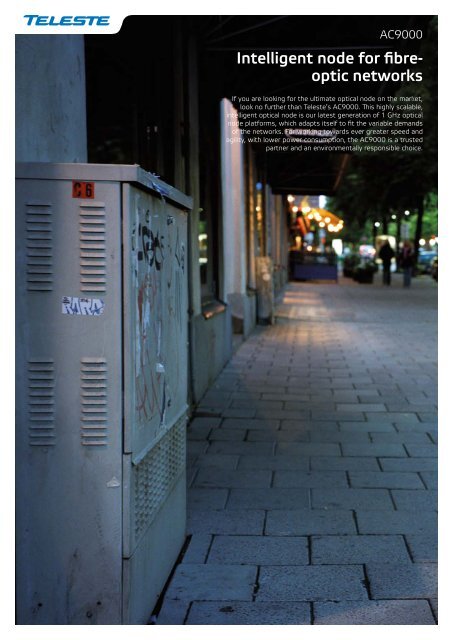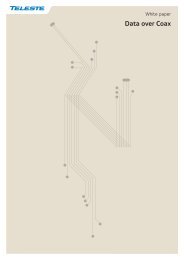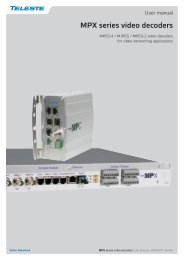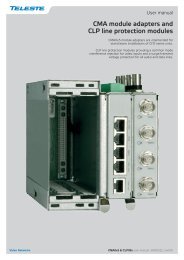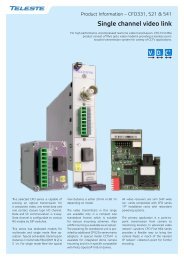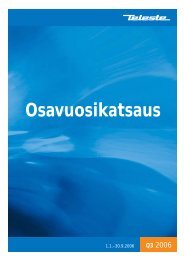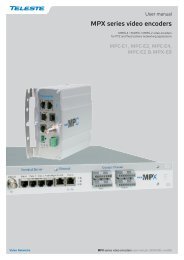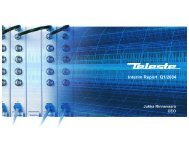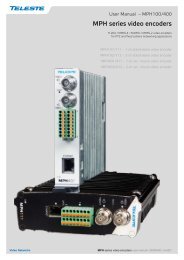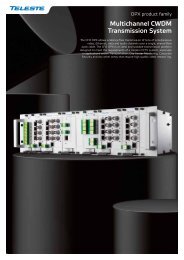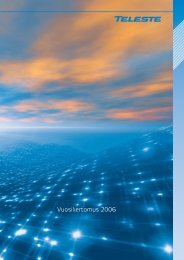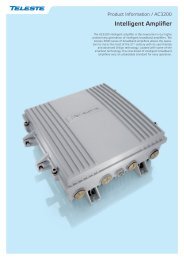Brochure: AC9000 Intelligent node for fibre optic networks - Teleste
Brochure: AC9000 Intelligent node for fibre optic networks - Teleste
Brochure: AC9000 Intelligent node for fibre optic networks - Teleste
Create successful ePaper yourself
Turn your PDF publications into a flip-book with our unique Google optimized e-Paper software.
<strong>AC9000</strong><br />
<strong>Intelligent</strong> <strong>node</strong> <strong>for</strong> <strong>fibre</strong><strong>optic</strong><br />
<strong>networks</strong><br />
If you are looking <strong>for</strong> the ultimate <strong>optic</strong>al <strong>node</strong> on the market,<br />
look no further than <strong>Teleste</strong>’s <strong>AC9000</strong>. This highly scalable,<br />
intelligent <strong>optic</strong>al <strong>node</strong> is our latest generation of 1 GHz <strong>optic</strong>al<br />
<strong>node</strong> plat<strong>for</strong>ms, which adapts itself to fit the variable demands<br />
of the <strong>networks</strong>. For working towards ever greater speed and<br />
agility, with lower power consumption, the <strong>AC9000</strong> is a trusted<br />
partner and an environmentally responsible choice.
Key strengths<br />
• Supports 1 GHz downstream and<br />
up to 85 MHz upstream<br />
• Wide range of upstream<br />
transmitters available with either<br />
Fabry-Perot or DFB lasers<br />
• Digital upstream transmitters<br />
• Automatic or manual ingress<br />
switching<br />
• Double power factor-corrected<br />
PSUs<br />
• Superior ESD and Surge<br />
protection<br />
<strong>Intelligent</strong> <strong>fibre</strong>-<strong>optic</strong> <strong>node</strong><br />
The <strong>AC9000</strong> is an intelligent <strong>fibre</strong>-<strong>optic</strong> <strong>node</strong> with best-of-breed<br />
functionality <strong>for</strong> increasing the quality and quantity of data and<br />
video services distributed within HFC <strong>networks</strong>. It is able to<br />
adjust itself automatically and effectively. The automatic features<br />
greatly reduce the possibility of human errors, as well as time<br />
consuming and inefficient network operations. Most importantly,<br />
it means cutting down operating costs and increasing customer<br />
satisfaction.<br />
Digital benefit<br />
All four traditional upstream transmitters can be replaced with two<br />
digital return path modules, thus providing savings on <strong>fibre</strong> infrastructure<br />
costs. The new digital return path technology also ensures<br />
an excellent upstream signal quality and allows longer <strong>fibre</strong> links.<br />
<strong>Intelligent</strong> upstream and downstream<br />
signal routing without any<br />
plug-in accessories.<br />
The AC699x transponder module<br />
is used to add remote connectivity,<br />
ALSC and upstream and downstream<br />
signal monitoring functionality<br />
to the <strong>AC9000</strong> <strong>optic</strong>al <strong>node</strong><br />
plat<strong>for</strong>m.<br />
The <strong>optic</strong>al transmitters and <strong>optic</strong>al<br />
receivers used in the <strong>AC9000</strong><br />
are equipped with a new, innovative,<br />
integrated <strong>fibre</strong> organiser <strong>for</strong><br />
easier module installation.<br />
Amplifier stages with the latest GaN<br />
technology ensure optimised power<br />
consumption and per<strong>for</strong>mance.<br />
A full range of transmitters using<br />
various laser technologies are<br />
available.<br />
The user-friendly design of the <strong>fibre</strong><br />
tray provides a convenient splicing<br />
and storing location <strong>for</strong> <strong>fibre</strong>-<strong>optic</strong><br />
cables. Individual <strong>fibre</strong> organiser<br />
modules allow easy access to each<br />
cable without disruption to surrounding<br />
cables.<br />
Position <strong>for</strong> CWDM multiplexer
Numerical fact<br />
<strong>AC9000</strong> <strong>Intelligent</strong> <strong>fibre</strong>-<strong>optic</strong> <strong>node</strong><br />
uses 40% less energy than comparable<br />
solutions on the market.<br />
40 %<br />
power<br />
saving<br />
No more unnecessary truck rolls<br />
Labour intensive network maintenance is often the prime reason <strong>for</strong> high operating<br />
expenses. This also means that manual network operations are prone to human error,<br />
which leads to unnecessary truck rolls and service interruptions. The <strong>AC9000</strong> tackles<br />
these problems by bringing intelligence to the network.<br />
With the <strong>AC9000</strong>, all configurations are done automatically without the maintenance<br />
crew having to adjust and configure each device separately. This capability is achieved<br />
through the use of a new microprocessor-based control system, which per<strong>for</strong>ms all of<br />
the adjustments automatically and without signal interruptions.<br />
Node <strong>for</strong> European <strong>networks</strong><br />
Environmental values and business benefits need not conflict. An efficient mechanical<br />
design optimising the use of manufacturing materials and high per<strong>for</strong>mance fitted into<br />
a small space greatly affect both capital and operational expenditure. All of this favours<br />
both the environment and the operator.<br />
As a <strong>node</strong> of compact size, the <strong>AC9000</strong> fits easily into European-scale street cabins,<br />
while the high per<strong>for</strong>mance means fewer units in the field. Low power consumption<br />
generates less heat, which increases component durability and – of course – leads to<br />
higher service quality and lower lifespan costs. Imagine how it would affect both your<br />
company’s expenditure and the environment if there would be x number of units in the<br />
network and if every unit would consume 40% less energy than conventional <strong>node</strong>s.<br />
Always in control<br />
Conventional mechanical adjustments and checking the parameters are laborious and<br />
time-consuming processes. The days of frequent periodic maintenance are over. In<br />
addition to being automatically aligned, the <strong>AC9000</strong> can be monitored and controlled<br />
remotely via the optional plug-in transponder unit included with <strong>Teleste</strong>’s CATVisor<br />
EMS network management software. The transponder unit offers three different<br />
management protocols: CATVisor, HMS and DOCSIS. If it is necessary to go on site,<br />
the <strong>AC9000</strong> can be configured locally via its USB interface using a PC or PDA equipped<br />
with CATVisor Commander software.<br />
<strong>AC9000</strong><br />
Energy efficiency<br />
Improved per<strong>for</strong>mance<br />
Reduce service outages<br />
Service reliability is one of the key factors in achieving and maintaining high customer<br />
satisfaction. Reducing service outages and providing better service to end-users will<br />
eventually result in a reduced churn rate and increased profitability.<br />
The <strong>AC9000</strong>’s comprehensive control system replaces conventional mechanical adjustments<br />
and the laborious checking of parameters with a reliable system that responds<br />
quickly to any indication of a problem. The early warning system allows you to rectify<br />
any inefficiency be<strong>for</strong>e it becomes a real problem, and reduces unexpected, costly<br />
downtime to an absolute minimum. In turn, this leads to several operational benefits,<br />
such as improved network reliability and per<strong>for</strong>mance.<br />
Guarantee the quality<br />
Even under the best of circumstances, maintaining a network with essential services<br />
can be a challenge. As the number of required high-quality services increases, there is<br />
a growing interest in systems that can guarantee the continuity of these services. The<br />
<strong>AC9000</strong> supports <strong>optic</strong>al link redundancy as well as redundant powering. The possibility<br />
of having different backup solutions provides simple and flexible switching architectures.<br />
Far too often, ingress can disrupt services and irritate end-users. The <strong>AC9000</strong> recognises<br />
and automatically isolates ingress with the help of an inbuilt ingress analyser. This<br />
is done even be<strong>for</strong>e your helpdesk has received a single call from subscribers blocked<br />
by the problem.<br />
Exploit the <strong>fibre</strong> to the max<br />
With network capacity needs and services increasing, there is not always enough existing<br />
<strong>fibre</strong>. Installing new <strong>fibre</strong> is always a laborious project involving high costs, and in<br />
some locations it is not a realistic option. There are essentially two ways to increase<br />
network capacity: utilise new <strong>optic</strong>al <strong>fibre</strong>s or increase the capacity of existing ones.<br />
Most operators are primarily exploring the latter approach when possible.<br />
In such cases, the digital return path is a new approach to offer an easy way to increase<br />
the capacity of existing <strong>fibre</strong>s. Using the <strong>AC9000</strong> with a 2 x 4 digital upstream<br />
option provides an operator with the potential to double the capacity of existing <strong>fibre</strong>s<br />
without major investments. The digital return path provides easy adjustment features<br />
and, most importantly, upgrades the network so that it is ready <strong>for</strong> future demands.<br />
The distance between <strong>node</strong>s can be extended up to 75 km. The digital return path<br />
carries two separate 5-85 MHz bandwidths at 5 Gbps. All of this is available in a size<br />
suitable <strong>for</strong> European street cabins.<br />
16 available wavelengths<br />
Simpliflied management<br />
<strong>AC9000</strong> and environment<br />
• Advanced GaN hybrids with<br />
automatic power optimisation<br />
• Power supplies with active power<br />
factor correction<br />
• Compact size with reduced<br />
material consumption<br />
• High per<strong>for</strong>mance means less<br />
active units in the field<br />
• Operational savings with a<br />
superior remote monitoring<br />
system<br />
Scaleable<br />
Compact<br />
Simpliflied management<br />
The AC7700 digital return path<br />
transmitter converts two analog<br />
upstream signals in the <strong>node</strong> into a<br />
single, digital CWDM carrier on any<br />
of the 16 available wavelengths<br />
over distances of up to 75 km.<br />
This possibility, together with the<br />
<strong>AC9000</strong>, allows multiple <strong>node</strong>s to<br />
share a common return <strong>fibre</strong>, making<br />
use of the existing infrastructure<br />
a cost- effective strategy.
The <strong>AC9000</strong> in a traditional HFC solution<br />
The <strong>AC9000</strong> is the preferred option <strong>for</strong> refurbishing in areas with low initial <strong>fibre</strong> penetration, when future proof of per<strong>for</strong>mance,<br />
scalability, cost efficiency, monitoring options and easy installations are prime concerns. The traditional solution offers:<br />
• Easy way <strong>for</strong> increasing broadband penetration and reaching out to new users<br />
• Access to high transmission capacity at a low cost<br />
The <strong>AC9000</strong> in a deep <strong>fibre</strong> solution<br />
The deployment costs <strong>for</strong> the whole <strong>optic</strong>al communication infrastructure are high, but the associated costs can be mitigated<br />
with an alternative approach. Existing coaxial <strong>networks</strong> can be updated using a hybrid solution where <strong>fibre</strong> cables are taken to the<br />
roadside and individual customer connections remain on a coaxial cable. The deep <strong>fibre</strong> solution offers:<br />
• Access to high transmission capacity at a low cost<br />
• Flexibility of installing <strong>fibre</strong> cable on demand, which minimizes initial installation costs<br />
• Less active components in the network
Technical specifications<br />
RF CHARACTERISTICS<br />
Downstream signal path<br />
Upstream signal path<br />
Frequency range 70...1006 MHz Frequency range 5...85 MHz<br />
Return loss 20 dB Return loss 18 dB<br />
Flatness ± 0.5 dB Ingress switching 0 / -6 / < -45 dB<br />
Gain limited output level 4 x 112 dBµV / 2 x 116 dBµV Input level 57.0 dBµV<br />
Slope control range 0…20 dB OMI adjustment 0…-20 dB<br />
Noise current density<br />
CTB 41 channels<br />
CSO 41 channels<br />
XMOD 41 channels<br />
5.5 pA / √Hz<br />
116.0 dBµV<br />
116.0 dBµV<br />
112.5 dBµV<br />
OPTICAL CHARACTERISTICS<br />
AC6610 <strong>optic</strong>al receiver<br />
Light wavelength 1290…1600 nm Optical input power -7…0 dBm<br />
Output level 72.5 dBµV Output level adjustment 20 dB<br />
AC6740 return path transmitter<br />
AC6745 return path transmitter<br />
Light source 1310 nm FP Light source 1310 nm DFB<br />
Optical output power +1 dBm Optical output power +3 dBm / +6 dBm<br />
Frequency range 5...65 / …85 / …200 MHz Frequency range 5...65 / …85 / …200 MHz<br />
Pilot frequency 4.5 MHz / 6.5 MHz / no pilot Pilot frequency 4.5 MHz / 6.5 MHz / no pilot<br />
AC67xx return path transmitters<br />
Light source<br />
CWDM units are available with DFB laser of 8 wavelengths.<br />
Optical output power<br />
+3 dBm / +6 dBm<br />
Frequency range<br />
5...65 / 85 / 200 MHz<br />
Pilot frequency<br />
4.5 MHz / 6.5 MHz / no pilot<br />
AC7700 digital return path transmitters<br />
Light source<br />
CWDM units are available with DFB laser of 16 wavelengths.<br />
Optical output power<br />
+5 dBm<br />
Frequency range<br />
5...65 or 5...85 MHz<br />
Bit rate<br />
5 Gbps in <strong>optic</strong>al link<br />
Analog to digital conversion<br />
12 bits<br />
Number of RF inputs 2<br />
Number of <strong>optic</strong>al outputs 1<br />
AC6991 TRANSPONDER MODULE (CATVisor and HMS ) | AC6980 TRANSPONDER MODULE (DOCSIS)<br />
RF modem<br />
RF level measurements<br />
Power consumption 1.8 W | 3.9 W DS measurement range 50…1006 MHz<br />
DS frequency range 80…155 MHz | 108…862 MHz US measurement range 5…85 MHz<br />
US frequency range 5…45 MHz | 5…65 MHz Measurement bandwidth 0.35 MHz<br />
DS input level range @ transponder 50…90 dBµV | 50…80 dBµV DS dynamic range 80…120 dBµV @ <strong>node</strong> out<br />
DS output level range @ transponder 75…104 dBµV | 70…112 dBµV US dynamic range 15…75 dBµV @ <strong>node</strong> in<br />
GENERAL CHARACTERISTICS<br />
Power consumption 61 W Dimensions (h x w x d) 360 mm x 350 mm x 140 mm<br />
Supply voltage 30…65 V AC Weight 10 kg<br />
Max current feed trough 12 A / port Operating temperature -40…+55°C<br />
Hum modulation 70 dB Class of enclosure IP54<br />
Optical connectors SC/APC, FC/APC, E-2000 EMC compatibility EN50083-2<br />
Output portss PG11 ESD 4 kV<br />
Test point connectors F female Surge 6 kV<br />
P4P_<strong>AC9000</strong>_03/12 Copyright © 2012 <strong>Teleste</strong> Corporation. All rights reserved. TELESTE is a registered trademark of <strong>Teleste</strong> Corporation.<br />
TELESTE CORPORATION P.O. Box 323, FI-20101 Turku, Finland, Phone +358 2 2605 611<br />
www.teleste.com


